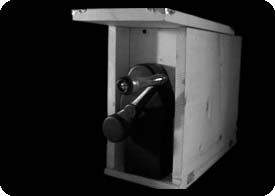the wooden lightbox:
a secret art of seeing
performance, ~50 min, 2007-2012
the wooden lightbox: a secret art of seeing is an exploration and reconfiguration of cinematic apparatus and emulsion. Using the early development of cinema as a marker for cultural, technological and economic change, these film cycles draw from turn of the century cinematic prototypes and long forgotten ideas surrrounding the moving image and its early promise. At the core of this approach is the use of a homebuilt hand-cranked projector in an expanded cinema format to present a striking array of handmade and processed emulsion. The vast potential of the film frame is drawn out through imagery both archaic and contemporary in shape and form. Hypnosis, panorama, motion studies, expectation, magic, the dreamworld and sleight of eye conspire in this intimate and immersive framework.
"... this shadowy twilight, the gentle susurrous of the projector, together with an echoey ambient soundtrack... subsumes the observer into numinous hinterland of atavistic images."
-John Smith, Kino Bambino, Newcastle.
“...[Mackenzie’s] work often has an otherworldly quality, as if we were seeing images for the first time...his process allows for the re-entry of a sense of wonder, what theorist Walter Benjamin once referred to as the promesse de bonheur, or the utopian promise of technology that can only be reproduced through an artistic reinvestment in the hidden possibilities of a medium. Through his rediscoveries, MacKenzie takes us back to the birth of the moving image...”
-Chris Kennedy, Strategies of the Medium III: In the Dark, Toronto (LIFT/Pleasuredome).
review by Gerald Saul HERE
details
the wooden lightbox: a secret art of seeing is performed live with a hand-cranked 16mm projector built and assembled from various relic 16mm projector and rewind parts and framed in a wooden box. Ten "chapters" are presented over the course of 4 reels. Film speed is varied manually by cranking more quickly or more slowly, while direction of the action is controlled by winding forward and backward. An average of 8 frames of 16mm can be cranked for every second of time elapsed. Colour gels are used to tone the black and white images while lens and hand interference are used to distort and/or partially obscure the image. Sound consists of a series of tracks shaped for the specific chapters and acting as guides to the progression of the images. TWL is an ongoing work in progress, an assembly of images entirely handprocessed and contact printed, transforming and developing as new materials are added and deleted.
approximate screening time: 50 minutes.
high resolution images:
still #1 | still #2 | still #3
image of projector
director stills #1 | #2 | #3
tech sheet (pdf)
screening setup schematic (pdf)
screening requirements
the projector is operated with a VERY dim bulb (50W), and so FULL darkness and relatively small image size in the screening space is crucial. this also enhances the intimacy and places the projector and performer in amongst the audience.
with two lens options, throw is as follows:
5 ft wide image=15 OR 30 foot throw
8 ft wide image=24 OR 48 foot throw
audio requires a line (mini stereo 1/8" female out) running to the same spot as the projector, and out from there to the house sound system - the mixer can sit by the projector if this is convenient.
